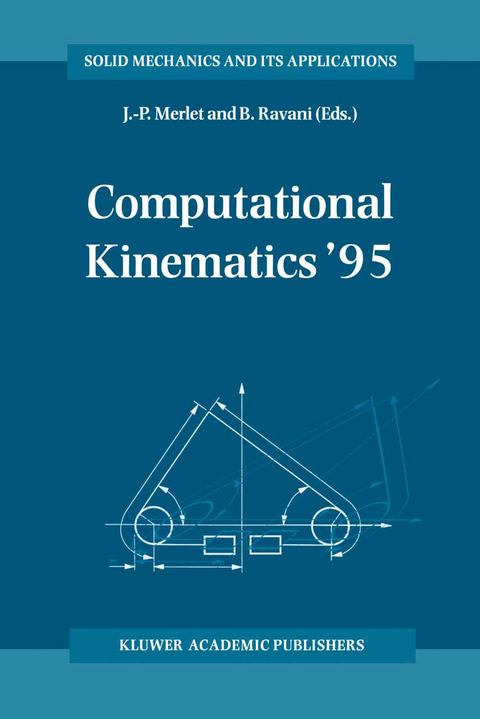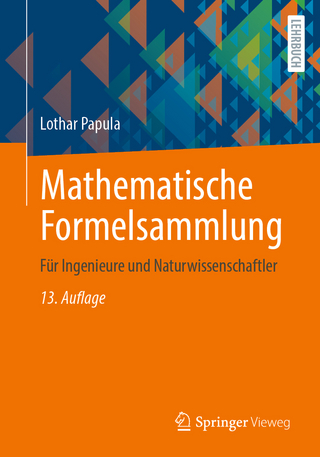
Computational Kinematics ’95
Springer (Verlag)
978-94-010-4147-8 (ISBN)
The aim of this book is to provide an account of the state of the art in Com putational Kinematics. We understand here under this term that branch of kinematics research involving intensive computations not only of the nu merical type, but also of symbolic as well as geometric nature. Research in kinematics over the last decade has been remarkably ori ented towards the computational aspects of kinematics problems. In fact, this work has been prompted by the need to answer fundamental questions such as the number of solutions, whether real or complex, that a given problem can admit as well as computational algorithms to support geo metric analysis. Problems of the first kind occur frequently in the analysis and synthesis of kinematic chains, when fine displacements are considered. The associated models, that are derived from kinematic relations known as closure equations, lead to systems of nonlinear algebraic equations in the variables or parameters sought. The algebraic equations at hand can take the form of multivariate polynomials or may involve trigonometric functions of unknown angles.
1 Kinematics Algorithms.- 1.1 Coordinate Free Criteria for Testing the Linear Dependence of the Sets of Screws.- 1.2 A Pseudo-dual Notation for Kinematic Calculations.- 1.3 Mobile Robot Localization by Cable-Extension Transducers.- 1.4 An Extension Theorem for Kinematic Systems of Equations.- 1.5 Applications of Clifford Algebras in Robotics.- 1.6 Elimination Methods for Spatial Synthesis.- 1.7 The Application of Finite Displacement Screws to Drawing Constraints.- 1.8 Real Root Counting for Some Robotics Problems.- 1.9 A Spatial Constraint Problem.- 1.10 Motor Tensor Calculus.- 2 Kinematics of Mechanisms.- 2.1 The Inverted Slider-Crank Used for the Design of an Approximated Straight-Line Mechanism.- 2.2 On the Choice of Independent Loops in Mechanism Kinematics.- 2.3 Symbolic and Numeric Computation for the Real-Time Simulation of a Car Behavior.- 2.4 On Minimum Joint Torque Configurations of Multiple-Link Manipulator.- 3. Singularities.- 3.1 A Determination of Singular Configurations of Serial Non-Redundant Manipulators, and Their Escapement from Singularities Using Lie Products.- 3.2 A General Criterion for the Identification of Nonsingular Posture Changing 3-DOF Manipulators.- 3.3 Identification and Classification of the Singular Configurations of Mechanisms.- 4. Workspace.- 4.1 Analytical Constraints for a Workspace Design of 2R Manipulators.- 4.2 A Hierarchical Representation of the Space Occupancy of a Robot Mechanism.- 4.3 Domains of Operation and Interference for Bodies in Mechanisms and Manipulators.- 4.4 Designing a Parallel Manipulator for a Specific Workspace.- 5. Parallel Manipulators.- 5.1 On the Isotropic Design of General Six-Degree-of-Freedom Parallel Manipulators.- 5.2 Stewart Platform Based 6-Axis Force and Torque Transducers.- 5.3 A Closed-Form Solution for the Direct Kinematics of a Special Class of Spherical Three-Degree-of-Freedom Parallel Manipulators.- 5.4 Algorithms for Kinematic Calibration of Fully-Parallel Manipulators.- 5.5 Parallel Redundant Manipulators Based on Open and Closed Normal Assur Chains.- 5.6 Forward Kinematics of a Parallel Manipulator with Additional Rotary Sensors Measuring the Position of Platform Joints.- 6 Motion and Grasp Planning.- 6.1 On the Modeling of Grasps with a Multi-Fingered Hand.- 6.2 A Special Class of C3 Rational Quartic Spline Curves for Two-Harmonic Trajectory Synthesis.- 6.3 Computing the Immobilizing Three-Finger Grasps of Planar Objects.- 6.4 A Dynamic Formulation for Planar Motions Using Geometric Kinematics and CAGD.
| Reihe/Serie | Solid Mechanics and Its Applications ; 40 |
|---|---|
| Zusatzinfo | X, 310 p. |
| Verlagsort | Dordrecht |
| Sprache | englisch |
| Maße | 160 x 240 mm |
| Themenwelt | Mathematik / Informatik ► Mathematik ► Angewandte Mathematik |
| Mathematik / Informatik ► Mathematik ► Geometrie / Topologie | |
| Naturwissenschaften ► Physik / Astronomie ► Mechanik | |
| Technik ► Maschinenbau | |
| ISBN-10 | 94-010-4147-4 / 9401041474 |
| ISBN-13 | 978-94-010-4147-8 / 9789401041478 |
| Zustand | Neuware |
| Informationen gemäß Produktsicherheitsverordnung (GPSR) | |
| Haben Sie eine Frage zum Produkt? |
aus dem Bereich


